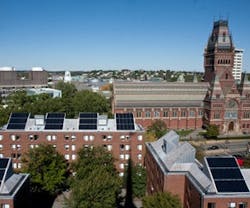Would you turn down free hot water for your building? A solar thermal system applies the sun's energy to water heating and offsets your energy consumption.
If you have the roof capacity for a PV array and building space for water storage tanks, you can capitalize on solar thermal technology.
The solar thermal system uses three basic steps:
- Energy is stored in solar fluid, typically glycol or water
- The fluid is moved through a network of pipes
- The heat is transferred to a storage water tank with a heat exchanger
Harvard University has several solar thermal projects, providing 20-60% of each building's hot water needs. Heather Henriksen, director of the Harvard Office for Sustainability, and Jay Phillips, senior director of operations at the Faculty of Arts and Sciences, discuss the advantages of solar thermal systems.
BUILDINGS: Why did Harvard pursue solar thermal?
Henriksen: Universities have a special role and responsibility to confront large global challenges. Harvard has committed to reducing 30% of its greenhouse gas emissions by 2016 from a 2006 baseline, including growth.
Our university-wide Green Building Standards also require energy modeling and energy-efficient design elements, including aggressive energy reduction targets of 30-34%. Innovative and cost-effective solutions like solar thermal help us to reduce energy, cut waste, and conserve resources.
BUILDINGS: How extensively is solar thermal used?
Henriksen: Harvard has solar thermal installations on office buildings, dormitories, and residential properties. The largest is the solar thermal system on the three-building dormitory of Canaday Hall. The project includes 3,200 square feet of solar panels and is projected to provide 60% of domestic hot water needs for 28 buildings in Harvard Yard.
Phillips: The Canaday system is also hybrid, combining a significant steam tunnel waste heat recovery component that works in tandem with the 150-panel solar thermal array. This was a very challenging design and exacerbated by the fact that there are few professional designers and installers that are familiar with such an installation.
We had our in-house engineers and maintenance teams actively engaged throughout all phases of this unique hybrid system. Searching for and selecting the proper design and installation teams were critical to the success of the project.
BUILDINGS: What is the level of investment for these projects?
Phillips: A solar thermal system like the one installed on Canaday's roofs is 55.4% efficient, compared with just 20-30% for a conventional fossil fuel system. The project will prevent an estimated 166 metric tons of CO2 from being released annually.
We have found that with renewable energy projects, it's more effective to focus on lifecycle cost analysis and net present value (NPV) through the lifecycle of the project. Using lifecycle analysis over simple payback shows the project's true efficacy.
The Canaday array has a 20-25 year lifecycle, giving the project a positive NPV. In contrast, the ROI has shifted and fluctuated between 10-14 years according to utility rate volatility.
BUILDINGS: What variables should owners be aware of?
Phillips: Solar thermal systems are very much impacted by the seasons. It is important to understand how to reject excess heat when the load is low but the solar harvesting is high. Calculating this heat reject mode is tricky but critical to understand when the energy model is developed.
When creating a routine maintenance program after commissioning, give serious consideration to having a solar installer augment the traditional maintenance contractor. Solar thermal systems are viewed by some as standard mechanical components, but failing to appreciate the uniqueness of the system could spell trouble with long-term operation.
BUILDINGS: What advice would you give to others?
Phillips: Solar thermal is a great solution and renewable energy strategy as long as there is a match with the heat sink.
Many people desire to install solar thermal but fail to give appropriate consideration to matching the thermal load properly. Having the proper heat sink for a solar thermal array is critical to the efficacy of the project.
Jennie Morton ([email protected]) is assistant editor of BUILDINGS.
About the Author
Jennie Morton
A former BUILDINGS editor, Jennie Morton is a freelance writer specializing in commercial architecture, IoT and proptech.
